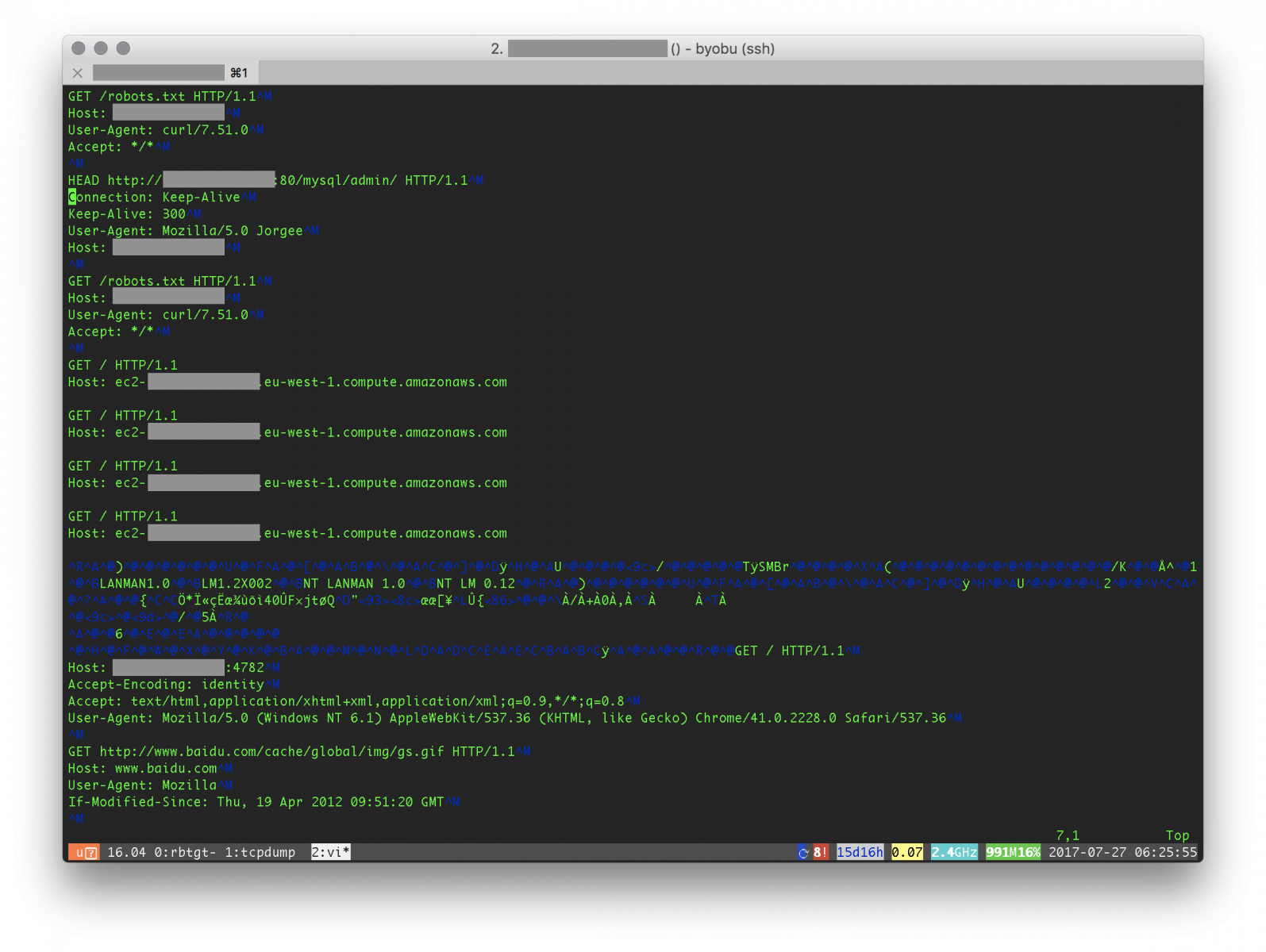TinyPot, My Small Honeypot
Running honeypots is always interesting to get an overview of what’s happening on the Internet in terms of scanners or new threats. Honeypots are useful not only in the Wild but also on your internal networks. There are plenty of solutions to deploy honeypots with more or less nice features (depending on the chosen solution). They are plenty of honeypots[1] which can simulate specific services or even mimic a complete file system, computer or specific hardware.
That’s cool but often such honeypots require a lot of dependencies (Python/Perl modules) or must be compiled. Sometimes, you just need to collect basic data to understand who’s knocking on your door. I was looking for a quick & dirty solution that does not require the installation of many packages or extra-tools. What are my basic requirements:
- Run on any Linux distribution
- Accept connections on ANY port
- Collect basic protocol details
- Log everything (of course!)
The first step is to capture the traffic on any TCP ports. To achieve this, we can use iptables to redirect any incoming connection to a specific port:
# iptables -t nat -A PREROUTING -p tcp --dport 1:65534 -j REDIRECT --to-ports 10000
Note: I limited the range to port 65534 to allow binding my SSH daemon to port 65535 (if you need to access the honeypot remotely).
The next step is to accept and establish a connection on any port (at least the TCP handshake). netcat[2] is the perfect tool for this and is usually installed by default with many Linux distribution. Let’s bind it to our collection port 10000 (see above) and log all the junk received:
# netcat -l -k -p 10000 | tee -a /tmp/netcat.log
Finally, a full packet capture is always nice to have, let’s collect all the traffic hitting our honeypot except the SSH management port:
# tcpdump -i eth0 -w /tmp/tcpdump.pcap -C 1000 -W 10 -lenx -X -s 0 not port 65534
Finally, we can put all the commands in a single script tinypot.sh. I'm using the "screen" command (also available in most distributions) to detach the tools from the console and to keep an eye on them later.
#!/bin/bash /sbin/iptables -t nat -A PREROUTING -p tcp --dport 1:65534 -j REDIRECT --to-ports 10000 /usr/bin/screen -S netcat -d -m /bin/netcat -l -k -p 10000 | tee -a /tmp/netcat.log /usr/bin/screen -S tcpdump -d -m /sbin/tcpdump -i eth0 -w /tmp/tcpdump.pcap -C 1000 -W 10 -lenx -X -s 0 not port 65534 echo TinyPot running, use "screen -r [netcat|tcpdump] to access tools"
Here is an example of data dumped by netcat:

We can see classic stuff like bots scanning for open proxies, SMB shares or searching for admin interfaces. What's next? Wireshark can be used to export statistics (menu "Statistics -> Conversations"). The generated CVS file once indexed in Splunk gives us the classic top-20:

Nothing fancy here and I'm sure that it can be improved but TinyPot just does the work!
[1] https://github.com/paralax/awesome-honeypots
[2] https://nmap.org/ncat/
Xavier Mertens (@xme)
ISC Handler - Freelance Security Consultant
PGP Key
| Reverse-Engineering Malware: Advanced Code Analysis | Amsterdam | Mar 16th - Mar 20th 2026 |


Comments
Couple of things I noticed in your script - the first command includes "screen -S test -d -m su - username..." which I don't think is supposed to be there, and the last command contains port 655534 instead of 65534.
Anonymous
Jul 27th 2017
8 years ago
I fixed it.
Anonymous
Jul 27th 2017
8 years ago
I used ncat for stability and it works well:
/usr/bin/screen -S netcat -d -m /usr/bin/ncat -l -k -p 10000 -C -o /tmp/netcat.log
Anonymous
Jul 27th 2017
8 years ago
Good to know, thank you for sharing! They are so many versions of the "netcat" tool...
Anonymous
Jul 27th 2017
8 years ago
Anonymous
Jul 27th 2017
8 years ago
{^_-}
Anonymous
Jul 28th 2017
8 years ago
I went with CentOS 7 Minimal install.
- Had to "yum install nmap-ncat screen tcpdump".
- The netcat command is /bin/nc
- Cent OS wants to use firewall-cmd instead of (on top of?) iptables.
- I could not get netcat to tee off, so I used -o.
- Find your firewall zone and interface with "firewall-cmd --get-active-zones"
(public ens33 for me)
The following seems to work for me:
#!/bin/bash
/usr/bin/firewall-cmd --zone=public --add-port=1-65534/tcp
/usr/bin/firewall-cmd --zone=public --add-masquerade
/usr/bin/firewall-cmd --zone=public --add-forward-port=port=1-65534:proto=tcp:toport=10000
#add timestamp and start netcat with logging
date > /tmp/netcat.log
/usr/bin/screen -S netcat -d -m /bin/nc -l -k -o /tmp/netcat.log --append-output -p 10000
/usr/bin/screen -S tcpdump -d -m /sbin/tcpdump -i ens33 -w /tmp/tcpdump.pcap -C 1000 -W 10 -lenx -X -s 0 not port 65535
echo Tinypot running, use "screen -r {netcat|tcpdump] to access tools"
Thanks for sharing!
dotBATman
Edit: Typo tap=>tcp
Anonymous
Jul 28th 2017
8 years ago